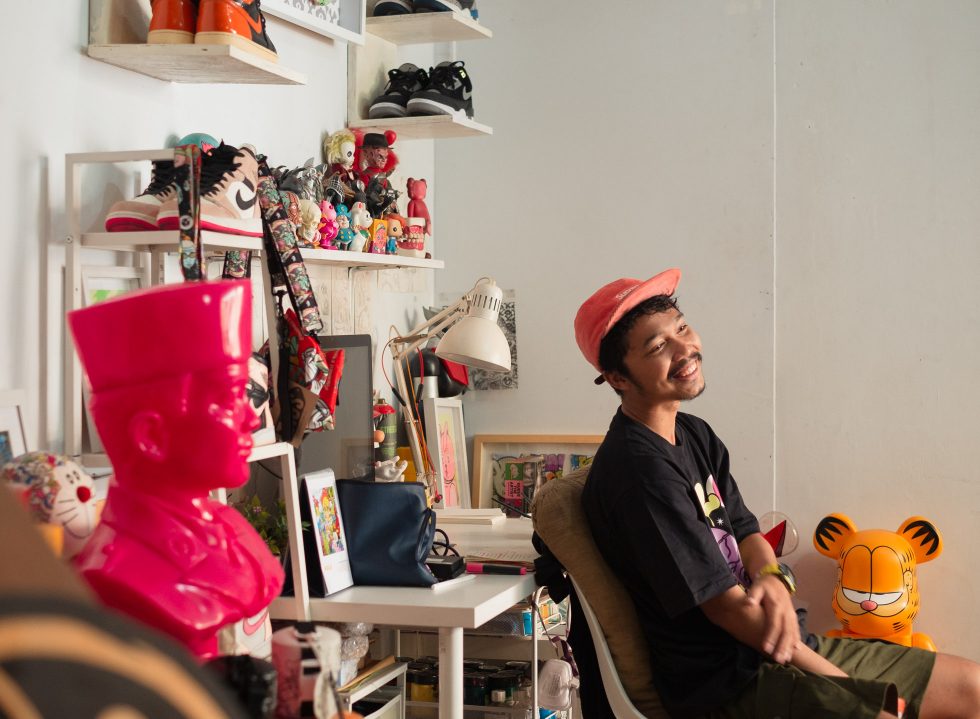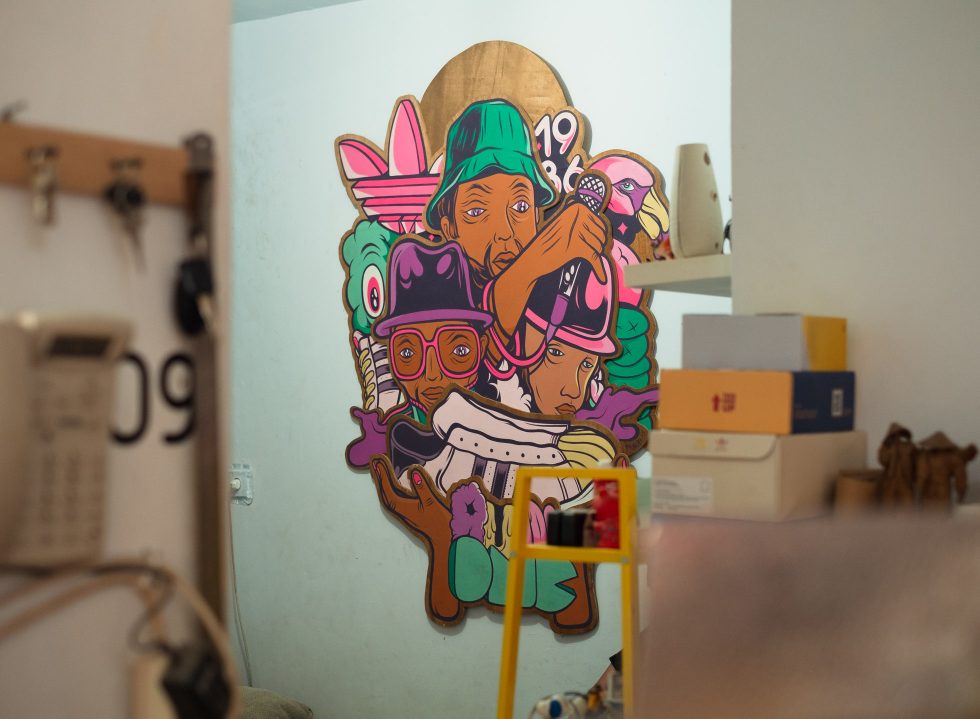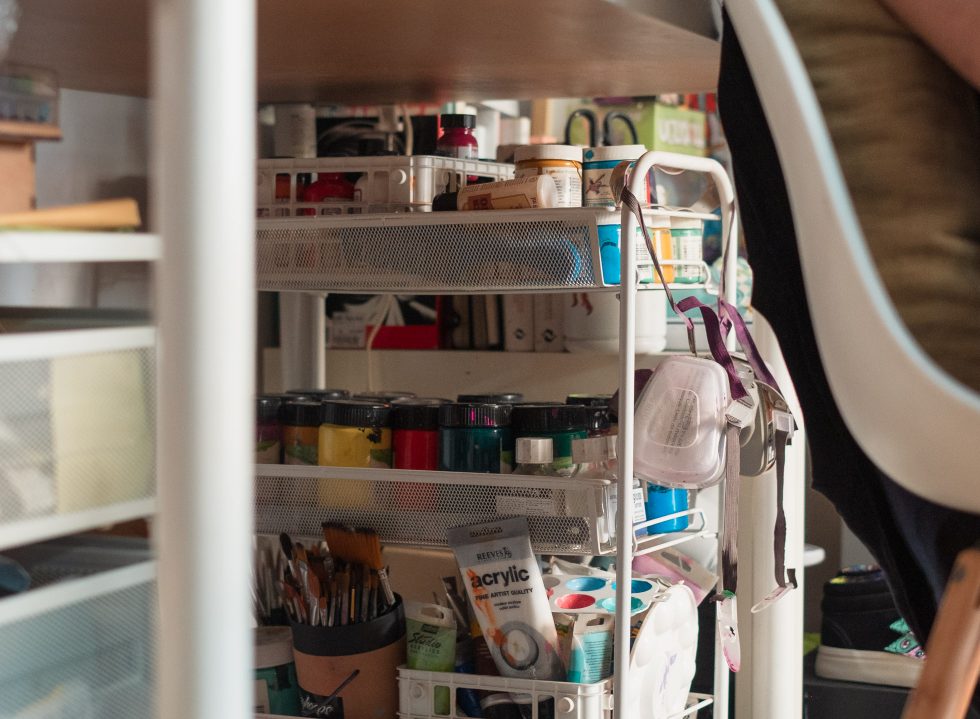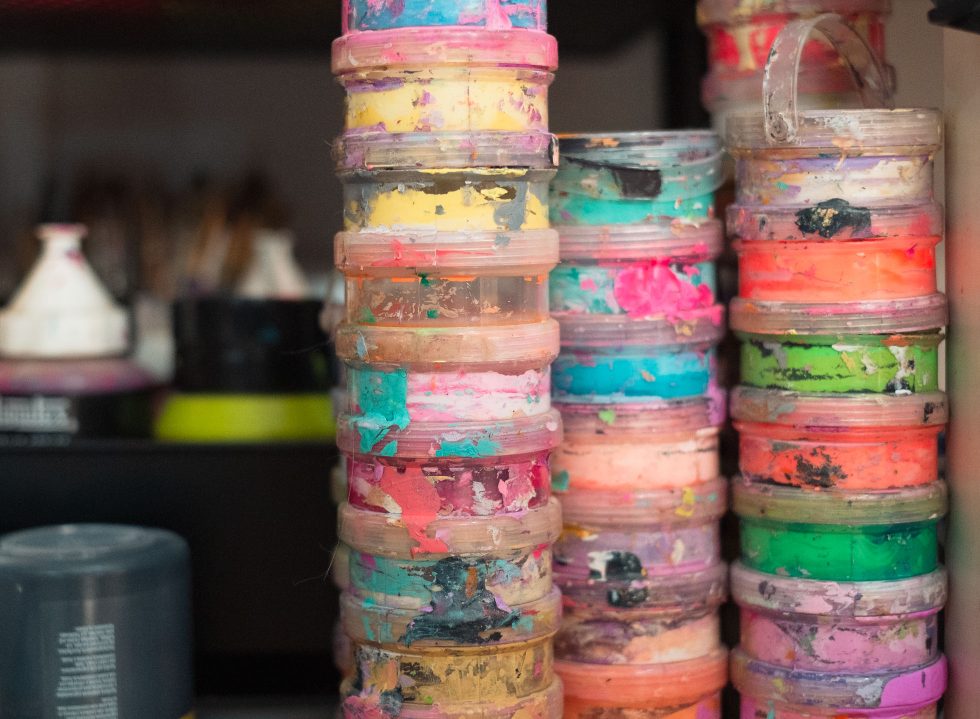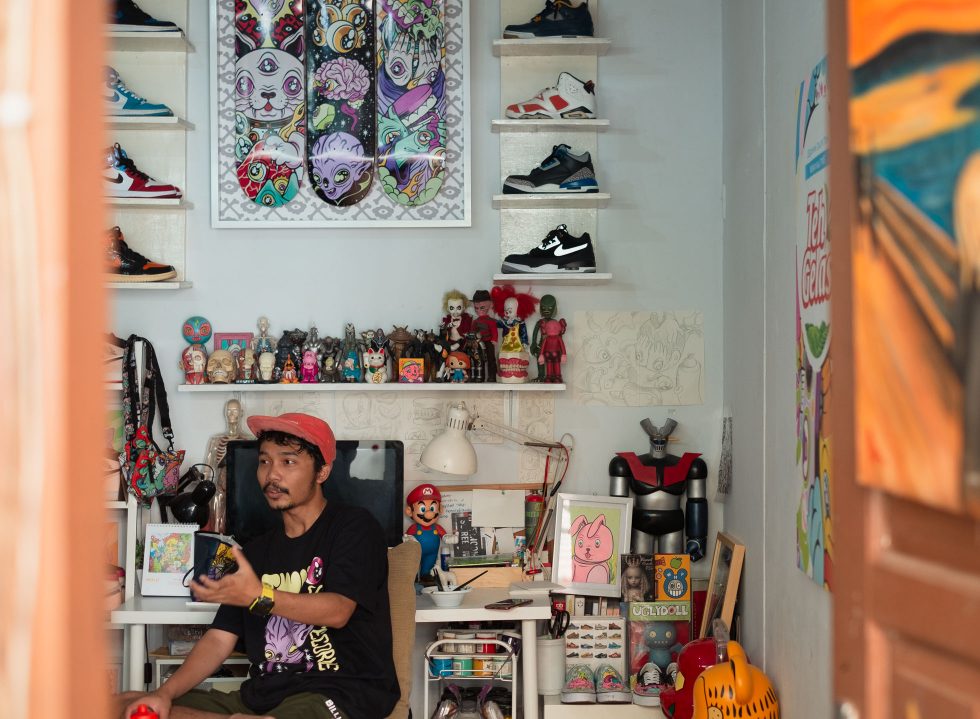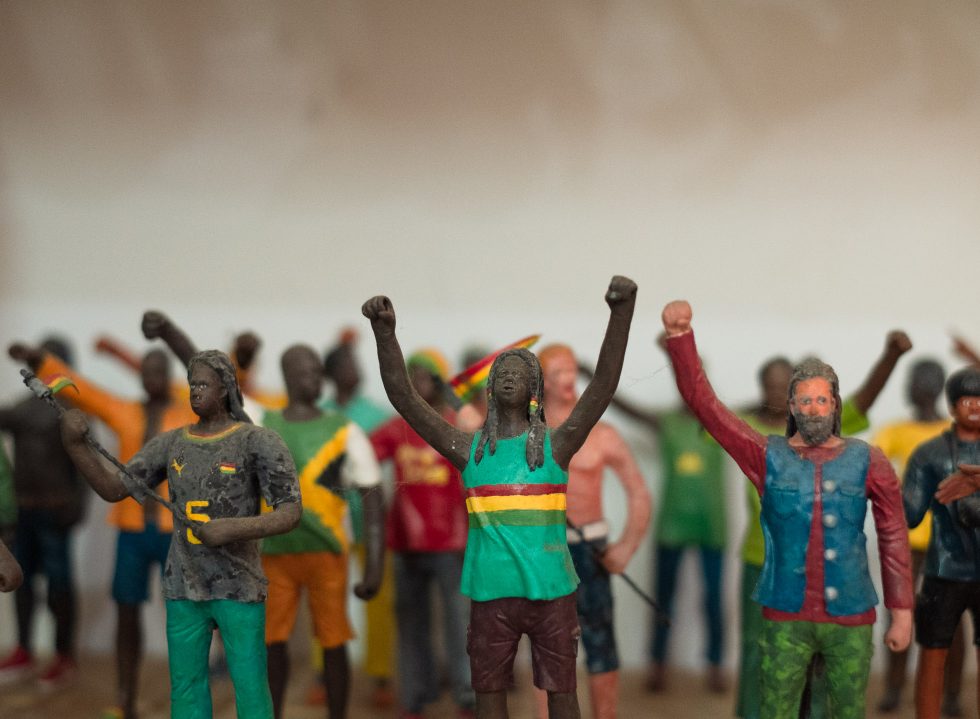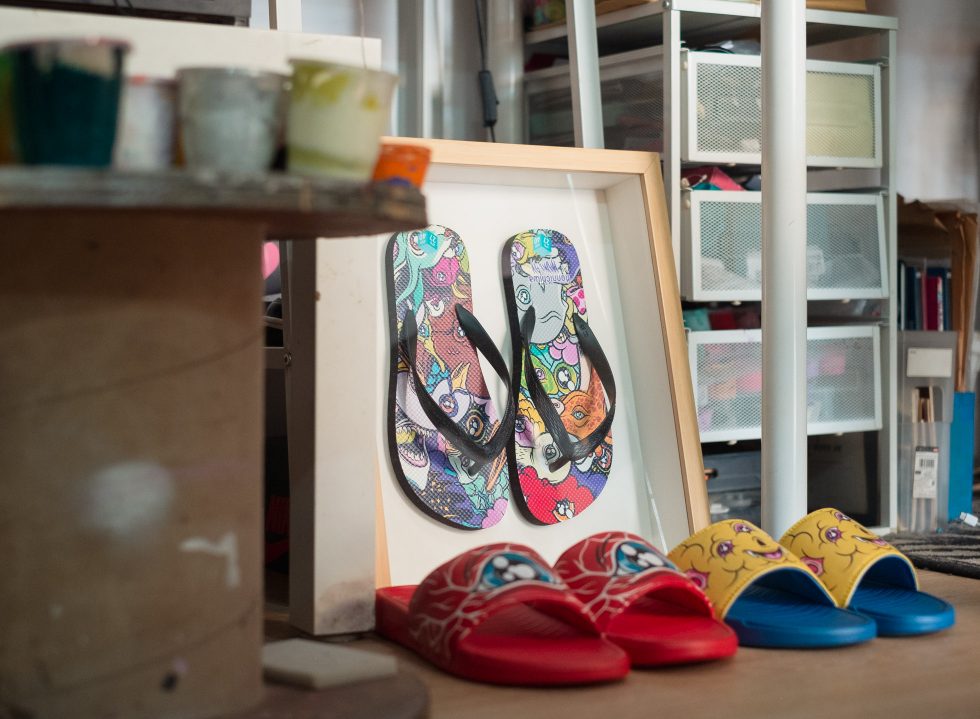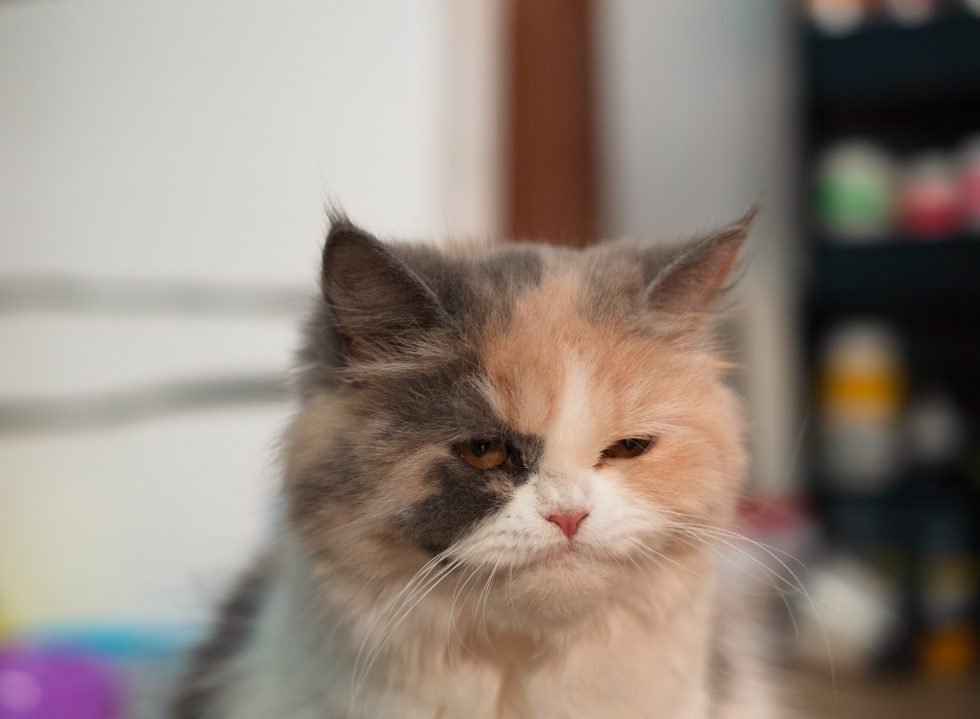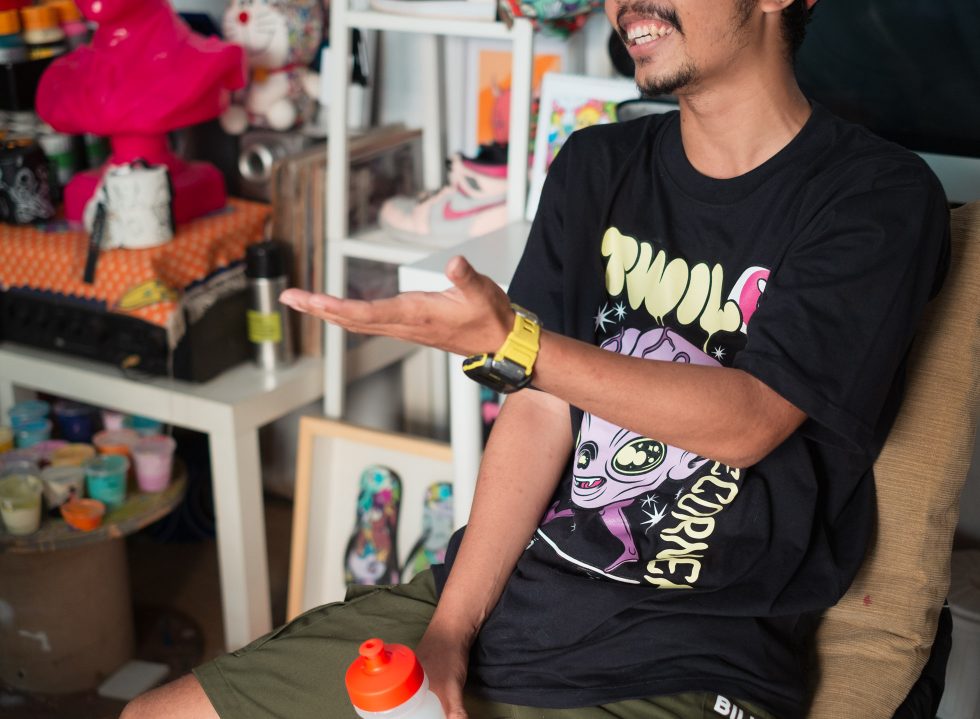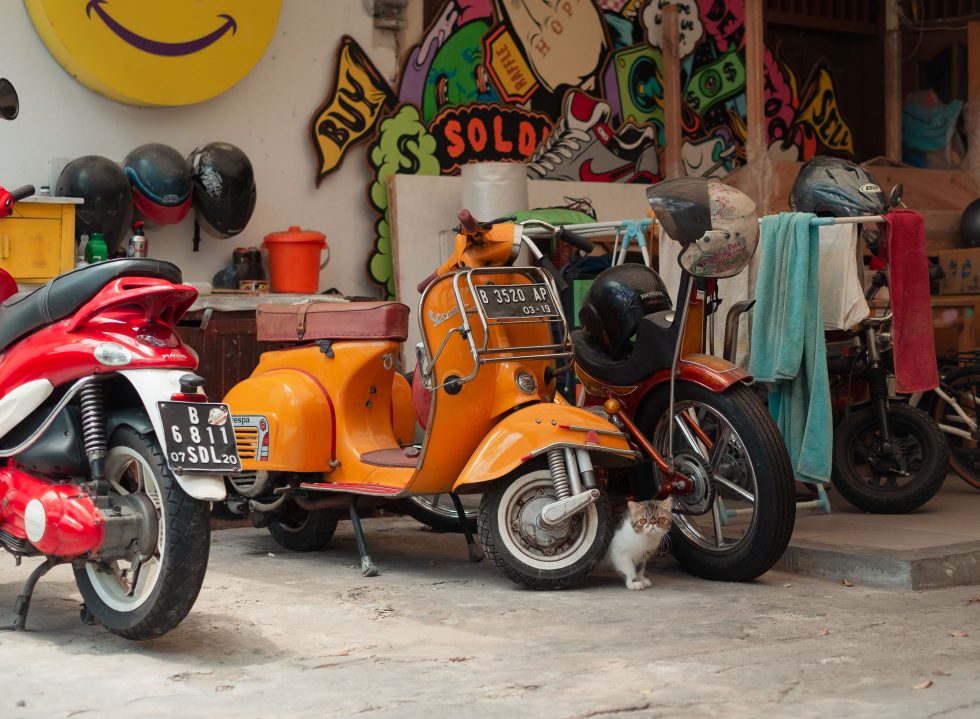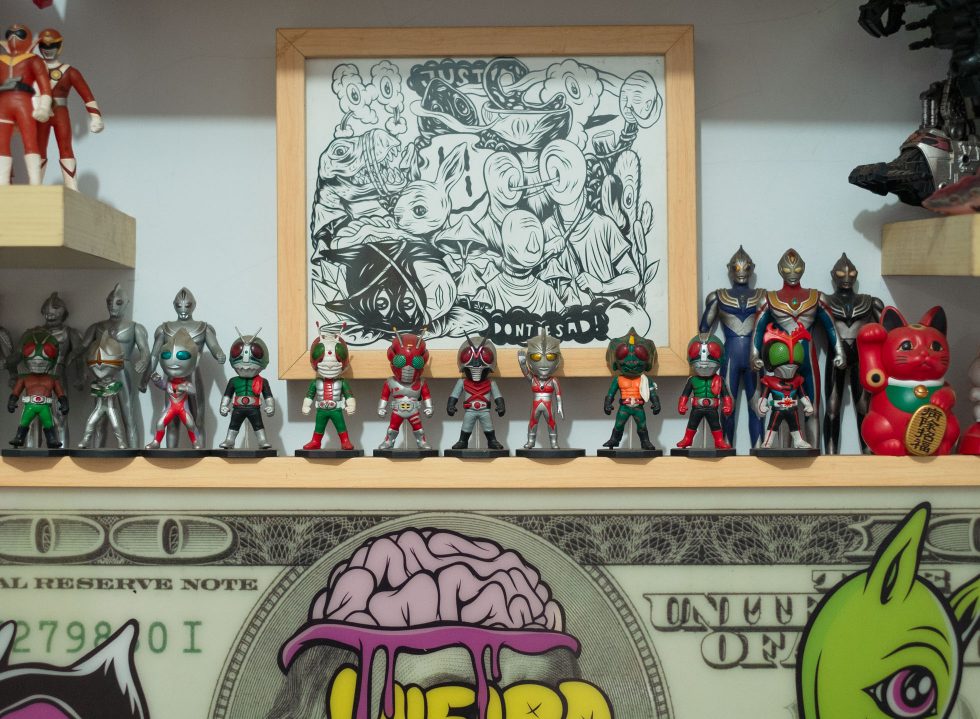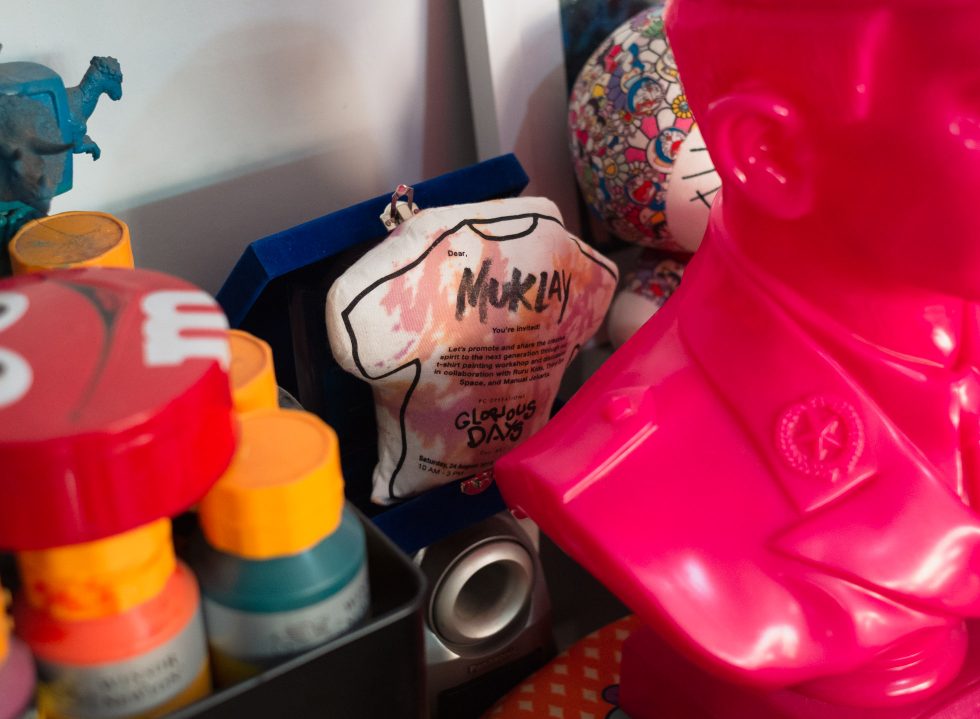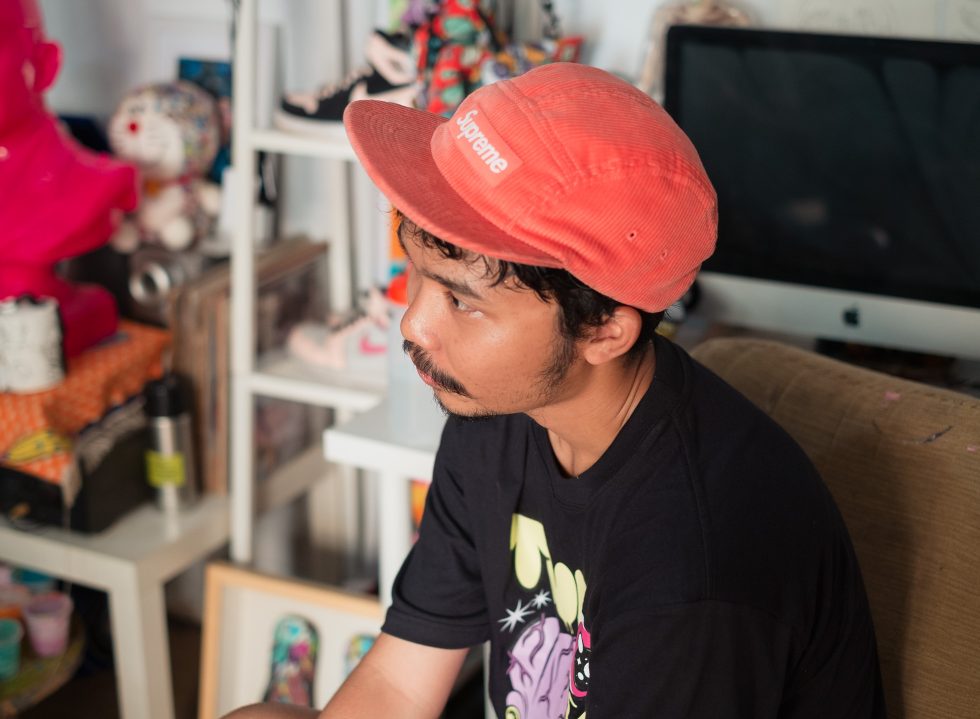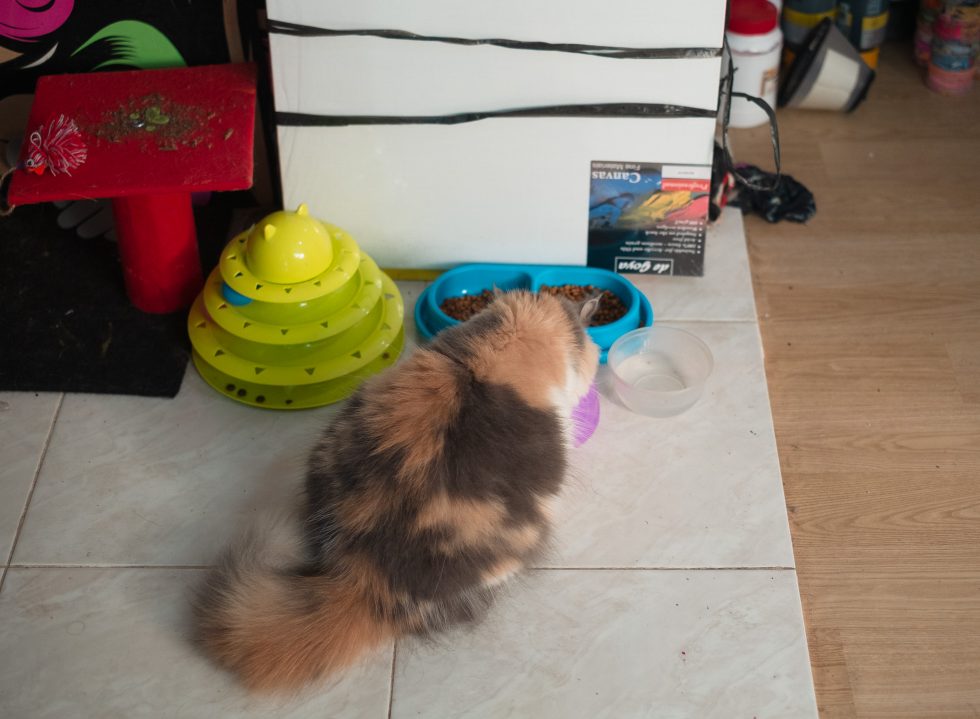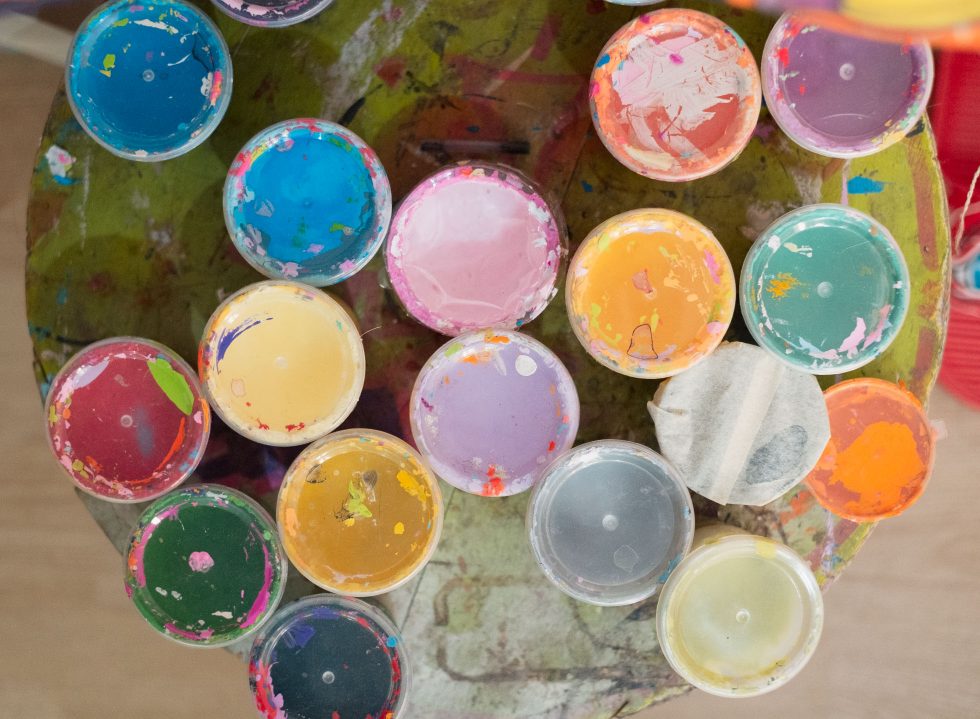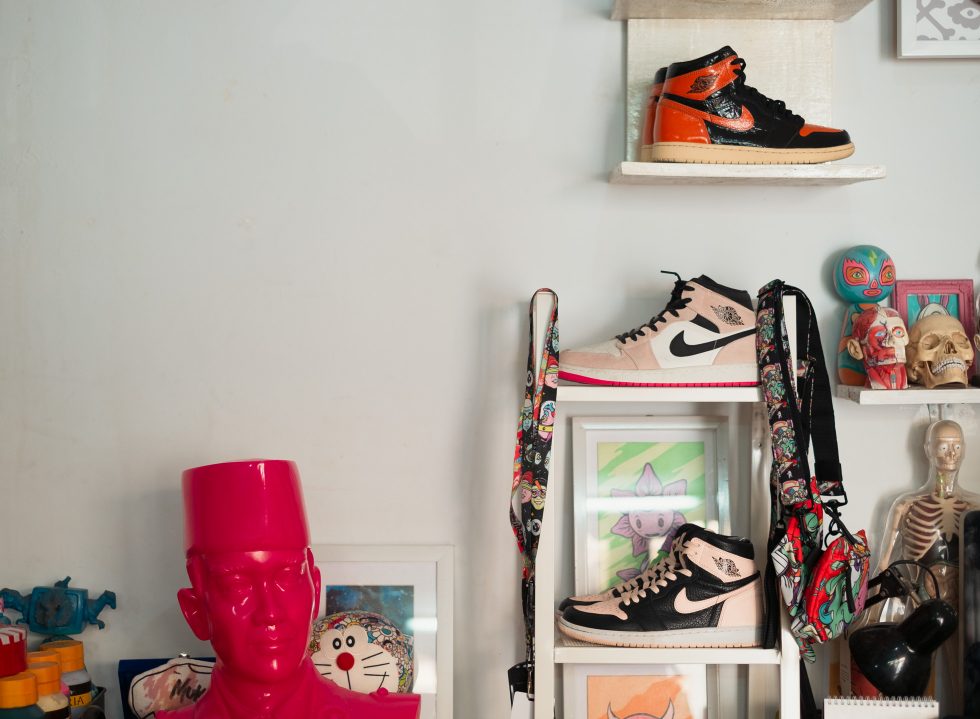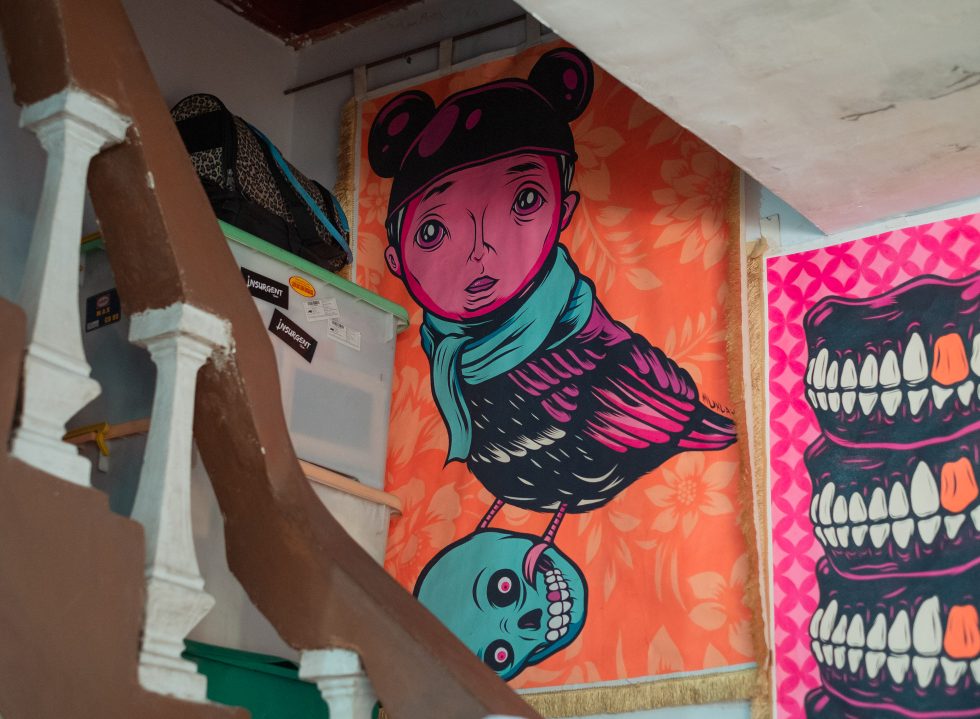Since secondary school, Muklay has been combining his talent for drawing with strong business acumen. What started as a desire to stand out from his peers, painting his sneakers soon became a source of monthly allowance as his friends started commissioning him to jazz up their sneakers. “I started by reproducing trendy artworks like Darbotz. Tokidoki illustrations on LeSportsac bags were also very popular. It was such a hype back then. There were a lot of bootleg versions in Mangga Dua. I like to browse them and then duplicate it on the shoes,” he says.
At that time, Muklay was still known as Muchlis Fachri until he joined a basketball team in high school. He explains, “When you’re in a basketball team, you need to wear a jersey and mine had ‘Muklay’ on the back of it. Back then it was trendy to add ‘-ay’ to your name. I wasn’t confident with that name initially, but got used to it eventually.”
Muklay would charge up to IDR 200,000 per commission. While most teenagers of his age wouldn’t think twice to spend money, his hard-earned revenue went to the purchase of paint and savings for new basketball shoes. “That’s how I kept the cash flow, bro.”
“The one important lesson I’ve learned was socialising.”
We are meeting in his studio on a blazing late morning in a quiet neighbourhood in East Jakarta. Muklay, who just stepped out from a shower, hair still wet when he throws on a cap, saunters to his seat in a black Twilo Skate t-shirt featuring his print, olive green short pants and a pair of pink pool sliders that are also imprinted with his unmistakable bright poppy art. As he rubs his face to perk himself up, he reveals that he had stayed up all night working on a commission.
It’s easy to detect the work of Muklay. In all his art, your eyes will be drawn to bright and lively colours: like Alice In Wonderland on acid, clamouring for your attention but never jarring or migraine-inducing. After moving past the colours, you’ll start to observe the familiar figures, a manic amalgam of characters that bring to mind the cartoons you used to love as a kid. There may be floating eyeballs or grotesque faces, but strangely, you’re never creeped out by it. A cartoonish utopia where optimism and neuroticism all rolled into one.
From his early exhibition at Art:1 Museum to his recent solo showcase at SH Art Project in Ginza, Tokyo, as well as countless collaborations with brands catering to the underground audience to working with Indonesian celebrities, Muklay’s impressive rise and success as an artist is no doubt fascinating. It’s a far cry from the boy who used to reproduce artworks on the shoes of his friends for extra allowance.
But it would be wrong to assume that it was all down to luck. For seven years of his life, Muklay had struggled with his undergraduate study as a result of a misstep. “I already had a clear idea but I was unsure. I eventually enrolled in UNJ (Universitas Negeri Jakarta) but didn’t major in Fine Arts, but Arts Education. When I looked at the curriculum, I was like ‘Oh no, it’s a mistake.’ Turns out what I was learning ways to programme arts education, teaching techniques and how to deal with misbehaving students. Oh well,” he sighs.
Muklay is frank in stating that he didn’t learn much during his time in university, except for one thing. “The one important lesson I’ve learned was socialising. Since I was studying to be a teacher in UNJ, I learned about art management, client interaction and socialising with people,” he recalls.
“When I buy sneakers and the colour combination feels right, I’ll incorporate that into my art.”
Muklay turned to art communities to find what was missing in university. Over at Kopi Keliling, an initiative that focuses on providing a platform for emerging artists, Muklay sold his very first artwork and began to hone in on the business side of art. “I learned how to continue to create while generating income at the same time. Before that drawing was just a hobby and my money was spent on buying paint.” Selling his artworks provided him with the boost of confidence that he needed and from that point on Muklay began to take his art seriously.
While the artist continued to have a fraught relationship with his university, Muklay’s final year project proved to be a jumping point in his career and even that was a coincidence he owed it to the South Korean art curator Jeong-Ok Jeon. Muklay was invited to show in the fifth Animamix Biennale at Art:1 Museum in 2017. He turned to the one thing that excites him the most: sneakers. Through bright and energetic artworks filled with sketches of sneakers and famous figures, he explored the relationship and the blurring line between street fashion and the art world.
“I never thought I’ll be able to exhibit in a gallery. For that particular exhibition, you can’t submit your works. You have to be invited. So I’m like ‘Okay, that means I’m starting to be taken seriously’. I mean I get to exhibit along artists like Eddie Hara and Oomleo. I’m like ‘Wow!’”
You don’t have to look far in his studio to learn that he’s a sneakerhead. Lining the stairs and walls of his studio are selected sneakers in vivid colours that are among his prized possessions. “I was often told that my colours are always right. I got all that from the Sneakers scene. When I buy something it’s because of the colours. So when I buy sneakers and the colour combination feels right, I’ll incorporate that into my art. It’s based on instinct.”
“The effects of collaboration can be amplified to such a level when done at the right time and right place.”
Back to the topic of being finally recognised as an artist, Muklay admits that he still feels like an outsider. “Up till today I still wonder if I’m really in the art scene. Because to be in the art scene is like being in a circle of socialites. Whereas I’m like a kid, and kids are not into stuff like that.” It can be daunting facing people outside of his comfort zone, but this is where his street-smart skills come in. “I can slip in because of sneakers. Let’s say there’s a collector, so I strike in with: ‘Wow, that’s LV. Where did you get it from? The resell price is this much now’. So if you were to be in that circle, you need to know how to start a conversation. It’s about knowing a bit of everything so that you have things to talk about with them.”
It’s safe to say that Muklay has amassed a strong following thanks to his openness to collaborations. One of his most notable collaborations is no doubt with the global Japanese fast fashion retail brand, Uniqlo back in 2018. Selected as one of the four artists from Southeast Asian countries, Muklay’s distinguishable art was introduced to the region via a humble t-shirt.
“I think collaborating is exciting because you get to meet new people. Right now I have three business models. The exhibition, where I create solely for myself. Then there’s commission—my main source of income. Finally, collaboration is like my marketing tool. You can’t exhibit forever, you need to have a system of managing for your art to spread far and wide. That’s why I decided to work on more collaboration projects.”
Still, his collaboration with Uniqlo that brought his art to a greater audience was just the start. In the same year, Muklay collaborated with RAN, the famous Indonesian pop-rock band, for the closing ceremony of 2018 Asian Games. The artist painted his signature art onto the denim jackets and jeans for their performance at the ceremony that was broadcasted globally. “It was then I realised that the effects of collaboration can be amplified to such a level when done at the right time and right place. To know the entire country saw my art; I was so proud of that moment,” he muses.
“People like to say that being an artist is all about freedom, it’s not.”
Muklay is also clearly not someone who confines himself to how a conventional artist operates, choosing instead to utilise different platforms to reach out to his audience, especially through his Instagram account. These days, some of his artworks are sold through Direct Message on the platform, although he confesses that he wasn’t thinking of profiting from Instagram when he started to be active.
As of now, Muklay has more than 50K followers and it is also through Instagram that brands reached out to him to be their brand ambassador, which is generally considered a taboo for an artist even to this day. “But I’m like oh well, let’s just try it. All this time my friends were saying how easy it is for me to earn money. But when I was a brand ambassador for Uniqlo, I had to be there during the release and be like ‘Hey guys’ [in front of an audience]. Turns out the so-called ‘easy money’ is not that easy after all.
“People like to say that being an artist is all about freedom, it’s not. Being an artist is not what it used to be,” he continues, noting that he’s feeling the duties and responsibilities of being a public figure. “I feel suffocated. That’s why a lot of my recent works show figures that are tied up or crushed. Even when it comes to managing my Instagram, I have to upload on certain timings and show the clients my [Instagram post] insights. It’s like you’re being rated by your statistics and engagements. What the fuck. That’s crazy. That’s the bad side of it. But what can I do?”
If the pressure wasn’t enough, Muklay also faces naysayers within the industry itself. “The good thing is, I’ve become more productive. So whether I have work to do or not, I always ‘feed’ my Instagram. It’s like feeding my cats daily. It’s just that other artists began to like ‘You’re just an Instagram artist!’. To me, it’s like, shut the fuck up cause I’m still exhibiting as well. We’re all in this field together. I hang around with Darbotz and Abenk [Alter], who are active on Instagram. Even overseas artists, their Instagram accounts are well managed.”
Muklay also lists Jean Jullien, the famous French graphic designer and illustrator with more than one million followers on Instagram, who regularly shares his works on the platform. “I wonder why so many artists are criticising fellow ones [for being active on social media] when they’re incapable of marketing their own works through social media. It’s like if you’re not even utilising the platform, why are you still making snarky comments [about those who do] behind their back?”
“Cat is life.”
Despite all of that criticism, Muklay has proved, time and time again, why he’s a force to be reckoned with. Early this month, he’s inducted to Forbes Indonesia 30 Under 30 2020. And this is why Muklay’s success story is such a satisfying narrative, albeit not a story of rag to riches. Nevertheless, it’s the story of a self-made underdog who continues to focus on his craft and punch above his weight.
You’d think that with all the success you’ll find Muklay in the scene, hanging out with the who’s who, but he prefers to stay in his studio, focusing on his work instead. When he’s not working, he spends his time sleeping and tending to his cats. He has more than 20 of them. Muklay leans back to his seat and chuckles, “Cat is life.”
